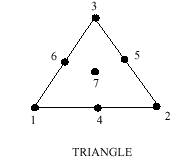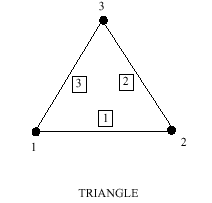

Cubit 15.8 User Documentation
The node numbering used for the basic elements is shown Figure 1. Specific element types of lower order just contain the number of nodes needed for those elements; for example, QUAD4 or QUAD elements use just the first four nodes shown for quadrilaterals in Figure 1.



Figure 1. Local Node Numbering for CUBIT element types
Element sides are used to specify boundary conditions that act over a length or area, for example pressure- or flux-type boundary conditions. Each element side is represented in the Exodus II format by an element number and the local side number for that element. The local side numbering for the basic elements is shown in Figure 2.


Figure 2. Local side numbering for CUBIT element types
A three-dimensional shell element with triangular topology will have the element type 'TRISHELL'. This type can be modified for different element orders by appending the number of nodes onto the end of the type. For example, a 6-node shell could have the element type 'TRISHELL6'. However, any element whose type begins with the 8 letters 'TRISHELL' in upper, lower, or mixed case will refer to an element with a triangular topology. The element can exist in either three-space or two-space.
Attributes:
1. If the element exists in two-space, there are no required attributes.
2. If the element exists in three-space, there is one required attribute which is the thickness of the shell.
3. If the number of attributes is equal to the number of nodes in the connectivity of the element, then the attributes are assumed to specify the thickness of the element at each of the elements nodes. The ordering of the attributes matches the ordering of the elements nodes.
The node ordering of the 3D triangle matches the node ordering of the 2D triangle as shown in Figure 3.

Figure 3. Local Node Numbering for CUBIT triangular element types
The sideset side ordering is different for the element in the 2D and 3D instances.
In 2D, the sideset side ordering matches what is shown in Figure 4.

Figure 4. Local sideset numbering for CUBIT triangular element types
In 3D, the sideset side and node ordering is the same as for a quad shell except that there are only 3 or 6 nodes.
Then:
side 1 == {1,2,3}
side 2 == {3,2,1}
side 3 == {1,2}
side 4 == {2,3}
side 5 == {3,1}
If it is a higher order triangular shell (6 [or 7 nodes]), then the higher-order nodes are added on to the end of the above:
side 1 == {1,2,3,4,5,6[,7]}
side 2 == {3,2,1,6,5,4[,7]}
side 3 == {1,2,4}
side 4 == {2,3,5}
side 5 == {3,1,6}